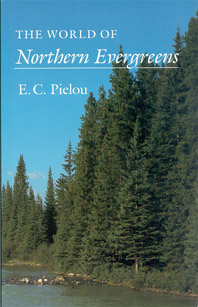 Comstock, Cornell University Press, Ithaca, New York, 1988, 174 pages, line drawings, maps
Comstock, Cornell University Press, Ithaca, New York, 1988, 174 pages, line drawings, mapsDid you know that
E. C. PIELOU
Denman Island, British Columbia
|
Contents
| ||
|
1 2 3 4 5 6 7 8 9 10 |
Preface
Origins of the Evergreen Forests Ten Groups of Conifers The Species The Reproduction of Conifers The Life and Growth of a Conifer Insect Pests of Conifers Fungi and Other Parasites The Elements: Fire, Wind, Snow, and Air Pollution Warm Blood: The Mammals and Birds of Coniferous Forests Companions of Conifers Epilog Suggested Further Reading Index |
ix
1 8 23 56 63 78 95 113 133 153 164 169 171 |